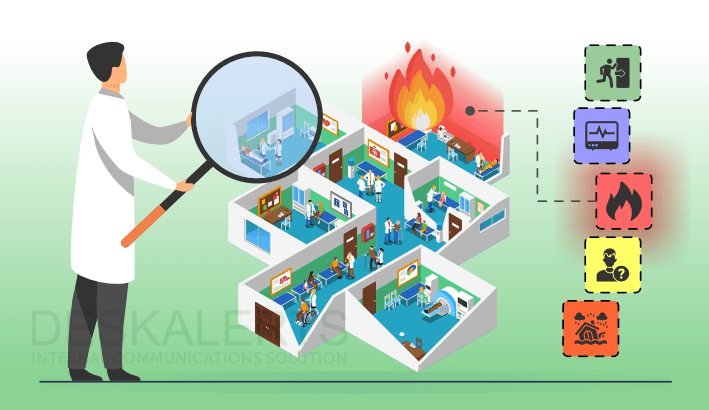
Table of Contents
About healthcare emergency codes
Why are hospital color codes important?
History of the emergency codes
Different codes in hospitals
About healthcare emergency codes
Color coding in hospitals and healthcare organizations is important for facilitating communication, enhancing efficiency, and ensuring the safety of patients, staff, and visitors. The use of color codes is a standardized practice that helps convey information quickly and accurately in high-stress environments. Here are several reasons why hospitals and healthcare organizations employ color codes:
1. Emergency response
Color codes are extensively used to signify different types of emergencies, allowing healthcare professionals to respond rapidly and appropriately. For example, a "code blue" typically indicates a cardiac arrest, prompting medical staff to rush to the specified location with the necessary equipment and expertise. Standardized hospital emergency codes help avoid confusion and ensure a swift response during critical situations.
2. Communication standardization
In a healthcare setting, where various personnel from diverse departments collaborate, standardized communication is essential. Color codes provide a universally understood system which minimizes the risk of misinterpretation or confusion. Whether it's emergency situations, patient conditions, or specific protocols, color-coded systems streamline communication and contribute to a more organized and efficient healthcare environment.
3. Patient safety
Color coding contributes to patient safety by helping healthcare professionals quickly identify patient conditions or requirements. For instance, color-coded wristbands may indicate allergy information, allowing staff to take appropriate precautions. This helps prevent medication errors and ensures that patients receive the correct treatment based on their individual needs.
4. Streamlining processes
In a fast-paced healthcare environment, every second counts. Hospital codes colors aid in streamlining processes, reducing response times, and improving overall workflows. By associating specific colors with certain actions or conditions, healthcare organizations can create a seamless system that minimizes delays and enhances the quality of care provided.
5. Disaster preparedness
During mass casualty incidents or disasters, color-coded systems become invaluable for managing resources, prioritizing patient care, and coordinating response efforts. Whether it's triage tagging or equipment allocation, color code medical alerts help healthcare professionals make quick decisions based on the severity and urgency of each case.
6. Training and education
Color coding simplifies training for healthcare professionals. New staff members can quickly learn and adapt to the color-coded system, ensuring a consistent and standardized approach to various situations. This not only accelerates the onboarding process but also helps to embed a culture of preparedness and accountability.
7. Regulatory compliance
Many healthcare accreditation organizations and regulatory bodies recommend or mandate the use of color codes as part of safety and quality standards. Compliance with these standards not only ensures the well-being of patients and staff but also contributes to the overall reputation and credibility of the healthcare organization.
8. Minimizing alarm fatigue
Hospitals are equipped with numerous alarms and alerts, and constant exposure to these sounds can lead to alarm fatigue among healthcare professionals. Color coding provides a visual cue, reducing the reliance on auditory signals and preventing healthcare workers from becoming desensitized to alarms.
Why are hospital color codes important?
Hospital color codes enable rapid and standardized communication in high-pressure healthcare settings. These codes convey critical information about emergencies, patient conditions, and procedures and ensure swift responses from medical personnel.
By using a universally understood color-coded system, hospitals can minimize confusion, enhance efficiency, and prioritize patient safety.
The codes streamline processes, aid disaster preparedness, and facilitate effective training, contributing to a well-organized and responsive healthcare environment.
How Hospitals Improve Emergency Communication in Real Life
Hospital codes are only effective when communicated quickly and clearly — to the right people, at the right time. Learn how real hospitals are turning emergency code procedures into seamless workflows.
Download our free guide 8 Real-World Use Cases: How Healthcare Teams Communicate Faster and Safer with DeskAlerts.
See how hospitals:
- Improve emergency response times
- Communicate code alerts across departments instantly
- Avoid confusion and alert fatigue
- Increase staff readiness in real-time

History of the emergency codes
The history of hospital color codes can be traced back to the 1950s when the U.S. military first implemented a system to standardize responses to various emergencies. This system was subsequently adopted by civilian hospitals to improve communication and coordination during crises.
Over time, organizations such as the National Fire Protection Association (NFPA) and the Emergency Care Research Institute (ECRI) developed standardized hospital code color meanings. In 2002, the Federal Emergency Management Agency (FEMA) also recommended color-coded wristbands for patient identification. Today, hospital color codes are globally recognized, with each color conveying specific information to ensure efficient and effective responses in healthcare settings.
Different codes in hospitals
Hospital color codes differ globally due to varying regional standards and healthcare systems. While some codes are consistent, others may have unique meanings or color associations. This diversity of hospital code colors is influenced by cultural, regulatory, and organizational factors, highlighting the need for flexibility and awareness in international healthcare practices.
All hospital codes aren’t the same, so its essential to consult the specific policies and procedures of the hospital in question to understand the exact meaning.
Here are the most common hospital codes and meanings currently in use:
Code purple in hospital
A “code purple” is one that can vary among hospitals, and there is no universally standardized definition for this code.
In some healthcare institutions, the code purple meaning be used to indicate a bomb threat (for example, in Australia) or security-related issue, while in others, it could signify a pediatric emergency or a response to a hostage situation (for example, in Canada) or a child abduction (In the USA). It can also simply stand for “medical emergency other than a cardiac arrest”.
Code grey in hospital
‘“Code grey” in hospitals in the USA generally refers to a situation involving a violent or combative person. The exact code grey hospital meaning may vary among different healthcare institutions, but it typically involves a protocol for managing aggressive behavior, ensuring the safety of patients, staff, and visitors.
Across jurisdictions in Canada, there are different hospital codes called grey that can indicate shelter in place, air contamination, system failures or infrastructure loss.
Code pink in hospital
What is code pink in a hospital? Across jurisdictions, a code pink often refers to an infant abduction, a pediatric emergency or a potential emergency towards pediatric patients.
Code blue in hospital
A code blue is a universal term used in hospitals worldwide to signify a medical emergency, specifically a cardiac or respiratory arrest The hospital code blue meaning typically involves the mobilization of healthcare professionals, including doctors, nurses, and respiratory therapists, to the location of the emergency.
Code white in hospital
A hospital code white can refer to an aggressive person, a neonatal incident or the need for an evacuation, depending on the hospital.
Code orange in hospital
What is a code orange? In some healthcare institutions, a “code orange” is used to indicate a disaster or mass casualty incident. This could involve a large number of injured individuals, a major accident, or a natural disaster, triggering an organized and coordinated response from the hospital and emergency services.
Code silver in hospital
What is code silver in a hospital? The exact meaning of “code silver” may vary among different healthcare institutions, but it generally indicates a potential danger related to an armed individual on the premises. When a hospital activates a code silver, iit triggers specific security and emergency response protocols. Hospital staff, including security personnel and law enforcement if necessary, will work to manage the situation upon recognition of this hospital emergency code.
Code green in hospital
The code green hospital meaning may sometimes be used to indicate an evacuation, while in others, it could represent a specific emergency related to a combative person or behavioral health situation.
Code red in hospital
A “code red" is commonly used in hospitals worldwide, and its meaning typically denotes a fire or a situation that poses an immediate threat to the safety and well-being of individuals within the healthcare facility. When a hospital code red is activated, it signals an emergency response to a fire or a potential fire hazard.
Code yellow in hospital
In many healthcare institutions a “code yellow” is often associated with a missing patient or a situation where a patient's whereabouts are unknown. In some US hospitals, a code yellow hospital response can refer to a bomb threat.
***
To communicate quickly in a hospital or healthcare setting, invest in DeskAlerts - a tool for internal communication that can be adapted for hospital color code systems by integrating color-coded alerts for various emergencies.
Customizable alerts with distinct colors and clear messages enhance visibility and urgency. Incorporating features like location-specific notifications ensures targeted responses.
DeskAlerts can serve as a centralized communication hub during crises, allowing quick dissemination of critical information to healthcare staff, aligning with hospital protocols and hospital emergency codes and improving overall emergency response efficiency. Regular training ensures staff familiarity with the system.
Emergency Codes Are Just the Start — Execution Matters Most
Understanding hospital codes is critical — but executing them through effective internal communication is what saves lives.
Download our free guide 8 Real-World Use Cases: How Healthcare Teams Communicate Faster and Safer with DeskAlerts.
Get real examples from hospitals using DeskAlerts to:
- Rapidly deliver emergency code alerts
- Reach staff across shifts and locations
- Eliminate confusion during high-stress events
- Improve outcomes through better coordination

FAQ
What are the color codes used in hospitals?
Color codes in hospitals are standardized systems for quick communication during emergencies and daily operations. These codes help streamline responses, enhance safety, and ensure efficient communication among healthcare professionals, contributing to a well-organized and responsive healthcare environment. Specific codes in hospital meanings may vary, so understanding a hospital's policies and what are the codes in hospitals is essential for accurate interpretation.
What are the Colours in medical coding?
In medical coding, colors are often associated with emergency response. Common hospital alert codes include "code blue" for cardiac emergencies and "code red" for fire incidents in hospitals.
What are hospital main colors?
There are a number of color codes in use in hospitals and other healthcare settings around the world. Typically, the most common hospital emergency codes are:
- Code Blue: Typically associated with cardiac or respiratory emergencies.
- Code Red: Indicates a fire or immediate threat to safety.
- Code Yellow: Used for missing patient situations.
- Code Silver: Signifies a security threat or a person with a weapon.
- Code Green: May denote evacuation or behavioral health situations.
These color codes help standardize communication in hospitals, allowing for quick and efficient responses to various emergencies and situations. When asking what are the different codes in a hospital, its important to remember specific meanings can vary, so hospitals often have policies outlining the exact protocols for each code.
Why is color coding important in hospitals?
Color coding is crucial in hospitals for quick and standardized communication during emergencies. Hospital codes colors enhance response times, minimize confusion, and contribute to efficient and organized healthcare operations.
What does the color coding indicate?
Color coding in hospitals indicates specific emergency situations or conditions, such as cardiac arrests, fires, missing patients, security threats, or behavioral health situations.
Why do hospitals use color codes?
Hospital code colors signify specific situations, enabling healthcare professionals to act promptly and appropriately, ultimately enhancing patient safety and overall healthcare effectiveness.
Are color codes the same in all hospitals?
All hospital codes aren’t the same. Color codes may vary between hospitals. While hospital code colors are universal, such as a “code blue”" for cardiac emergencies, the meanings of other hospital alert codes can differ. It's crucial to familiarize oneself with the specific hospital codes and meanings employed by each hospital, as interpretations may not be universal.
 Caroline Duncan
Caroline Duncan








